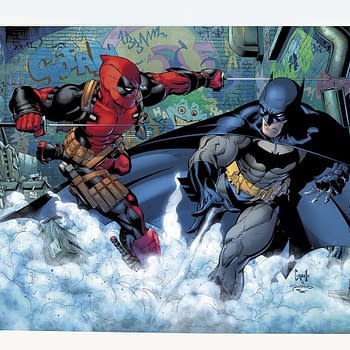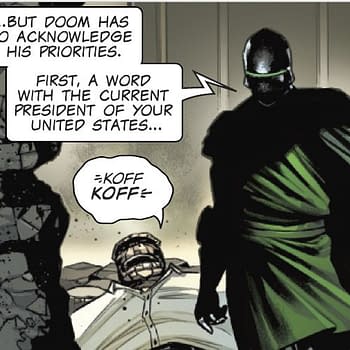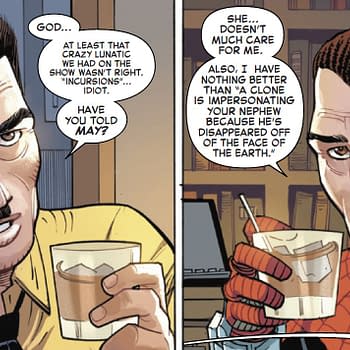Posted in: Comics | Tagged: Byron Brewer, chris roberson, Comics, doc savage, dynamite, entertainment, the shadow
Modern Pulp Fiction – Chris Roberson Part II
Earlier Byron Brewer was talking to Chris Roberson on bring his run on Doc Savage to an end, but the writer has two classic pulp series on their last issue this month. Byron talks to Chris about wrapping up his run on The Shadow with issue #35.

CHRIS ROBERSON: It was a very different experience. The way I've always described it is that MASKS was a story that had the Shadow in it, but it wasn't a Shadow story. There simply wasn't room in the group dynamic of all of those pulp heroes to include much about the Shadow's own supporting cast. But in THE SHADOW, I was able to bring a lot of the agents and other characters on stage and give them a chance to shine. Because ultimately, the Shadow pulps were as much about the agents and their adventures as they were about the Shadow, in a lot of respects.
BB: You had, ironically enough, 13 issues' worth of the dark avenger, from #13-25. How would you say the Shadow has changed or grown, if any, during your tenure? Or is he a character who is timeless?
CR: Oh, I don't think that the Shadow as presented in Walter Gibson's stories ever really changes or grows. That kind of development took place in the character's backstory, before the first pulp novel even began. So you can show change and growth with a flashback story like Matt Wagner and Wilfred Torres's SHADOW: YEAR ONE, but not in the kinds of stories that Giovanni Timpano and I have been telling.

CR: I think there's a certain purity to those characters. The most successful of them have a strong visual element to them, and their basic character set up can be explained in just a few short sentences. It's not necessary to understand a huge mythology or continuity in order to get up to speed.
BB: For the new reader who may be seeing this, tell us about the Shadow, his specific world, how you approached them as a writer, and how that approach may have changed over the months.
CR: The Shadow is the weird avenger of the night, a mysterious figure in a slouch hat and flowing scarf who dispenses justice from the barrels of his twin .45s, aided in his pursuit of justice by a cadre of hand-picked agents.

CR: With those other "masked avenger" pulp types, their masked identities are an act, at least in part. Underneath the hat and mask they are regular guys with relatable motivations. With the Shadow, the guy in the hat and scarf IS the real guy, and his motivations and feelings are largely kept from us. When we see him in his "civilian" identity, THAT is an act. So there's a kind of brutal simplicity to his dialogue. He is what he appears to be, and says exactly what he means.
BB: The Shadow, of course, in mainstream pop culture is known best for the classic radio show of days gone by, and with tech being what it is, many folks may have access to those old radio shows today. How has Dynamite's Shadow differed from this 1930s/'40s man of mystery, especially under the pen of Chris Roberson?
CR: The Shadow that we've most often seen in the comics is closer to the character from the Orson Welles radio dramas than the one presented in Walter Gibson's pulp novels. I tried to bring a bit more of the pulp novel version of the character back into the mix, so that what we have in these stories is a blend of the two.

CR: My favorite is probably The Golden Master, if only because I have a real weakness for the character of Shiwan Khan. As for my personal favorite of the stories from my run? I was really pleased with the way Light Of The World came together.
BB: I really liked your stories involving the mystic Light. What led to her creation, her story?
CR: It occurred to me in thinking about the Shadow is that the only thing that separates him from a murderous villain is that the reader agrees with the Shadow's morality. He punishes the wicked and defends the good, so we accept that he mows down countless thugs with a hail of semiautomatic gunfire, laughing all the while. But what if the Shadow had different moral standards? What if, instead of punishing "crime," where innocents are harmed, he punished "sin," in which people did things that were bad for themselves? From there it was a simple matter of flipping the script (an Eastern woman trained in the mystic arts of the West rather than a Western man trained in the mystic arts of the East).
BB: I loved the globe-hopping aspect of the Shadow book. He even went deep into Mother Russia in #20! Was there some locale you would have liked to have taken our crime fighter that fate did not allow?
CR: Walter Gibson drew upon his own life experiences in writing the Shadow. If he was staying at a vacation home on the beach, for example, the Shadow would end up going to the beach. So maybe a story set in Portland? Could have been fun!
BB: Where is noir-scribe Chris Roberson headed now?
CR: Still churning out issues of EDISON REX, the supervillain-turned-hero story that Dennis Culver and I are putting out through Monkeybrain Comics. Writing an ALIENS miniseries for Dark Horse that is being illustrated by Patric Reynolds. And wrapping up DOC SAVAGE with Bilquis Evely for the good people at Dynamite!
For more on The Shadow, click here.














